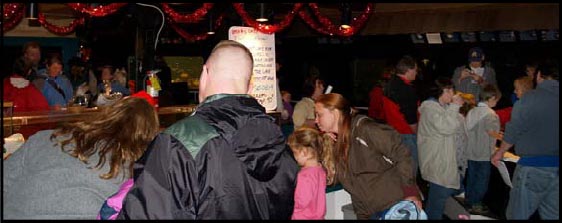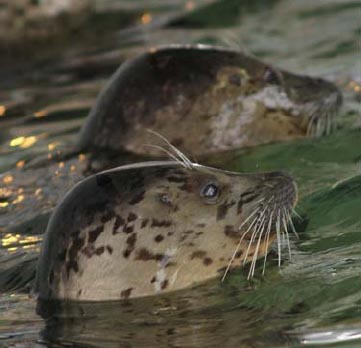
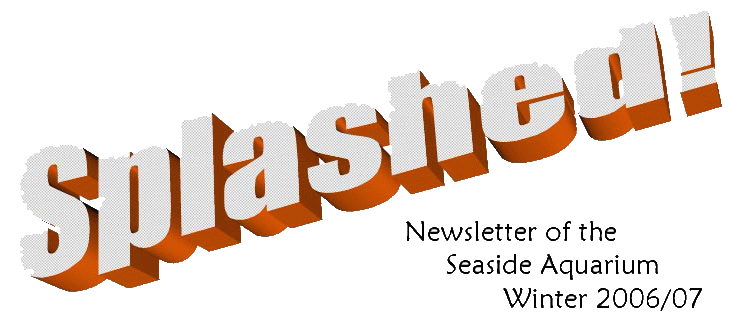
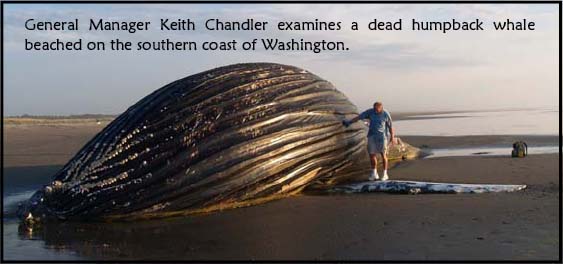
Wind and currents carry unusual things onto the beach
throughout the year. Some are just unique oddities,
others require response from the Aquarium. Staff spend
many hours every year on the beach or outdoors in the
region noting local phenomena. Responses vary considerably
depending on need. If itís a huge herring influx at the
cove that brings in bait-seeking dolphins, it may only
require passing the information to local news agencies so
the public has an opportunity to share the experience.
If itís a dead marine mammal, it can require our staff,
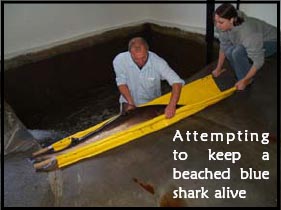 leaders of the local Marine Mammal Stranding Network,
to assist in dissections to determine the cause of death.
Live marine mammals are left on the beach with signs
warning the public to remain at a safe distance.
Exhausted birds pummeled by the surf are brought in
by the public to rest at the aquarium and are released
back into the estuary or are transferred to the Wildlife
Rehab Center. If itís a sea turtle or live animal, staff
coordinate with larger aquariums to stabilize and transport
the animal to someplace it might be rehabilitated.
After large winter storms, they comb the beaches for
kelp to feed the animals and possible skate egg casings.
Some of the animals that wash ashore are not particularly
unique in the ocean, but are unique to see appear on local
beaches.
(continued page 2)
leaders of the local Marine Mammal Stranding Network,
to assist in dissections to determine the cause of death.
Live marine mammals are left on the beach with signs
warning the public to remain at a safe distance.
Exhausted birds pummeled by the surf are brought in
by the public to rest at the aquarium and are released
back into the estuary or are transferred to the Wildlife
Rehab Center. If itís a sea turtle or live animal, staff
coordinate with larger aquariums to stabilize and transport
the animal to someplace it might be rehabilitated.
After large winter storms, they comb the beaches for
kelp to feed the animals and possible skate egg casings.
Some of the animals that wash ashore are not particularly
unique in the ocean, but are unique to see appear on local
beaches.
(continued page 2)
Inside:
|
Community Open House
The Seaside Aquarium held an open house December 9 to encourage the community to visit the aquarium and donate to some local good causes. Admission was free all day and for every can of food donated, visitors received a container of fish to feed the seals.
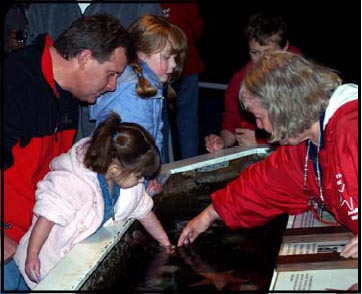 Over 600 cans, totaling 400 pounds of food, were collected for
the local food bank. Six hundred nine
visitors attended the festivities. In the interpretive
center, visitors were greeted by aquarium staff and
volunteers from the Haystack Rock Awareness Program,
a nonprofit organization that interprets at the base
of Haystack Rock every spring and summer. The ten
volunteers shared information on local intertidal marine
life. Visitors also had the opportunity to view recently
hatched octopus babies
(see article page 3)
. The timing
on this unique opportunity was perfect. Weíve had
some hatch out this week, but a bunch more hatched
yesterday. This is the largest number in the tank Iíve seen
so far, commented Tiffany Boothe, the aquariumís publicist.
Over 600 cans, totaling 400 pounds of food, were collected for
the local food bank. Six hundred nine
visitors attended the festivities. In the interpretive
center, visitors were greeted by aquarium staff and
volunteers from the Haystack Rock Awareness Program,
a nonprofit organization that interprets at the base
of Haystack Rock every spring and summer. The ten
volunteers shared information on local intertidal marine
life. Visitors also had the opportunity to view recently
hatched octopus babies
(see article page 3)
. The timing
on this unique opportunity was perfect. Weíve had
some hatch out this week, but a bunch more hatched
yesterday. This is the largest number in the tank Iíve seen
so far, commented Tiffany Boothe, the aquariumís publicist.
